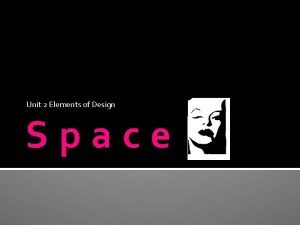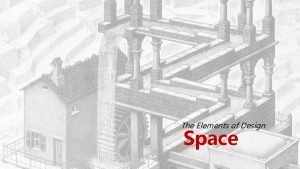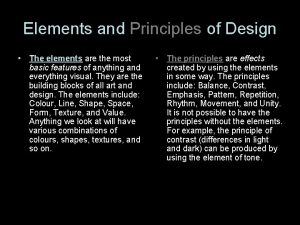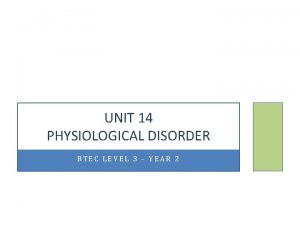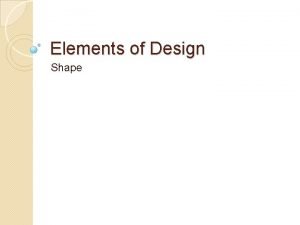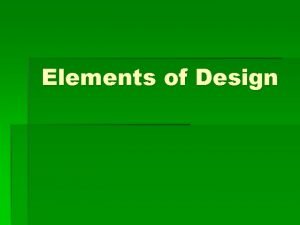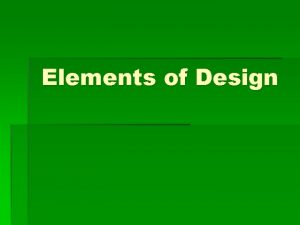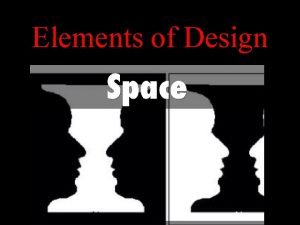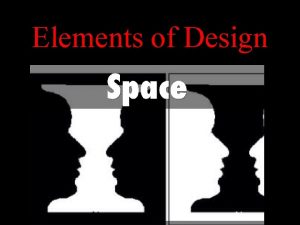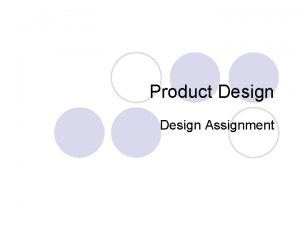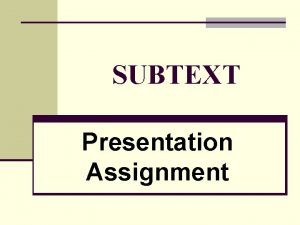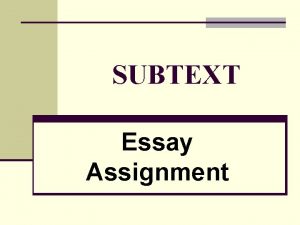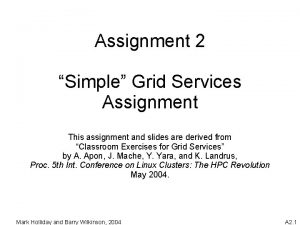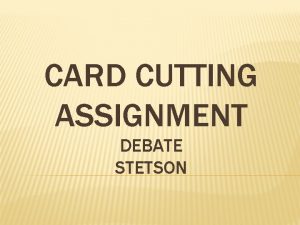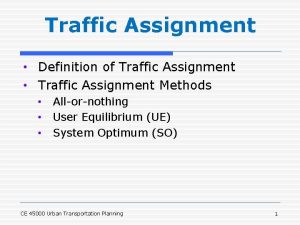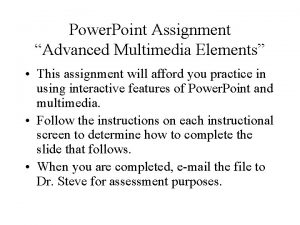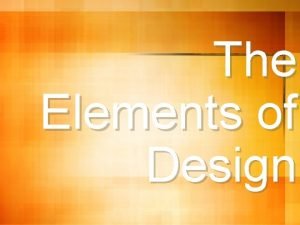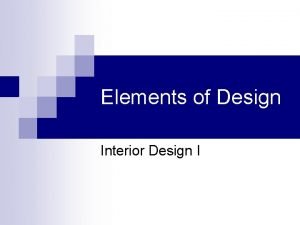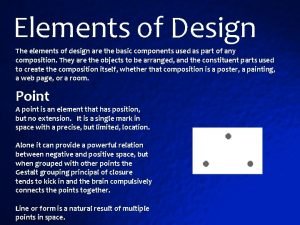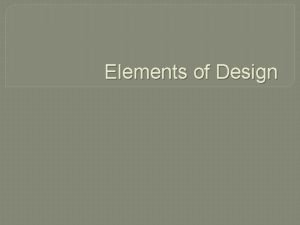Unit 2 Elements of Design Space Assignment 2

























- Slides: 25

Unit 2 Elements of Design Space

Assignment 2 introduction…

The space is our paper. My negative space is the black paper. My positive space is the white paper. What picture did I make?

Positive and Negative Space Design 1. Cut a large shape from a sheet of black paper. 2. Cut this shape into 9 or more large pieces. 3. Using a sheet of white paper as your background, reform the cut up pieces of black paper back into their original shape. 4. Expand the shape by gradually sliding the pieces apart. Experiment with different amounts of negative space between the pieces. 5. After deciding on the most pleasing arrangement of space, glue the pieces on the white paper.

S P A C E �The most important element of design. �The area a designer works with as well as the area between objects.

Space Design Options �Fill the space Depends on personal preference and the function of the room. Add positive space ▪ Furniture, floor coverings, accessories, wall hangings, . . �Leave much of it empty ▪ Accept the negative space �Divide it ▪ Furnishings, floor coverings, columns, partitions…

Fill the space…

Leave it empty…

Open Floor Plan vs. Closed Floor Plan

Positive Space �Space that is used up or filled furnishings, wall art, area rugs Clutter is positive space EXAMPLE: the desk

Negative Space �Empty or open space Area around furniture, wall backgrounds, EXAMPLE: the area under and around the desk

Positive and negative space �The positive and negative space should be balanced in amount and placement. Although, some areas are primarily positive space or primarily negative space.

Positive and Negative in Design

What do you see? Positive or Negative?



Space Design Analysis �On the back of your space design, explain how adding negative space to the positive space made the design more interesting. � In your description explain the space being used (is it mostly positive or negative), The emotions invoked form the design (sadness, content, seductive, hunger), where the idea of the design came from (personal taste, life changes, goals, hobbies), and what significance it has to interior design (why is positive or negative space important in interior design? ).

�Too much space and not enough space. �Use the Elements of Design to make the available space seem open and spacious or smaller and intimate.

Small Spaces � Small space gives the feeling of: ▪ Protection, comfort, security, establish territory, pride, ownership, opportunity to personalize own space. ▪ Restriction, confinement, restlessness, frustration How to make small seem large: 1. Use light colors 2. Wall to wall neutral floor colorings 3. Small-scale furnishings 4. Mirrors 5. Generous light from more than 1 source 6. Smoothly textured surfaces or textures with little pattern

Small Space This small space is planned so that the individuals living here can have freedom and comfort at the same time.

Large space �Large space gives the feeling of: ▪ Freedom, mentally soaring into a place devoid of restrictions, stimulation ▪ Insecurity, inadequacy, desire to return to the safety and security How to make a large space seem small: 1. Medium to large scale patterns 2. Dark or vivid colors 3. Area rugs 4. Large-scale artwork, 5. Multiple furniture groupings

Large space Even in a large loft, furniture can be arranged to make a conversation area inviting.

Different sizes of space convey different feelings �Well designed small spaces can make people feel snug and secure. ▪ Uncomfortable small spaces give a feeling of confinement. �Large, open spaces give many people a feeling of freedom and luxury. ▪ Too much empty space can make someone feel lonely and uncomfortable

Test our knowledge: Looking at this space, analyze the way it is used. How is the overall space divided into areas for storage, work, and relaxation? Was the space well planned in this room for its function (a favorite spot for family, friends, and to gather)?

Design A Space Assignment � Off of a master bedroom is a 10 x 12 sitting room with 1 window. How will you open up and use this space? � Draw a 10 x 12 space on graph paper and select a place for the 1 window. Each square = 1 foot (10 squares x 12 squares) � Experiment with different placements and combinations of furnishings. � What colors and textures will you use on the wall, floor, and furnishings? � Cut out and mount the room design. � Give it a title � Write a paragraph about your choice of space design. Explain how you opened up the space and the feeling you created.
 Elements of design assignment
Elements of design assignment Elements of design space
Elements of design space Steve magada trio
Steve magada trio Principles of interior design ppt
Principles of interior design ppt Unit 10, unit 10 review tests, unit 10 general test
Unit 10, unit 10 review tests, unit 10 general test Cartesian space trajectory planning
Cartesian space trajectory planning Space junk the space age began
Space junk the space age began Camera space to world space
Camera space to world space Unscented trajectory chapter 5
Unscented trajectory chapter 5 World space to screen space
World space to screen space Unit 5 assignment 2 business
Unit 5 assignment 2 business Unit 22 assignment 2
Unit 22 assignment 2 Unit 14 health and social care level 3
Unit 14 health and social care level 3 Njnin
Njnin Unit 14 physiological disorders assignment 1
Unit 14 physiological disorders assignment 1 Unit 5 meeting individual care and support needs coursework
Unit 5 meeting individual care and support needs coursework Unit 1 exploring business assignment 2
Unit 1 exploring business assignment 2 Btec business level 3 unit 1 assignment 2
Btec business level 3 unit 1 assignment 2 Unit 5 data modelling assignment 2
Unit 5 data modelling assignment 2 Unit 5 health and social care assignment
Unit 5 health and social care assignment Btec business unit 4 assignment 2
Btec business unit 4 assignment 2 Unit 1 exploring business assignment 2
Unit 1 exploring business assignment 2 Unit 14 learning aim d health and social care
Unit 14 learning aim d health and social care Unit 3 digital portfolio assignment 1
Unit 3 digital portfolio assignment 1 Unit 2 computer systems assignment 1
Unit 2 computer systems assignment 1 Unit 14 investigating customer service assignment 1
Unit 14 investigating customer service assignment 1
